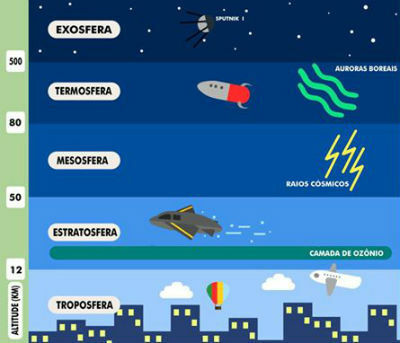The troposphere is the lowest layer of the Earth's atmosphere, being the region in which we live and where meteorological phenomena occur.
Its height varies according to the point of distance from the surface. At the poles, for example, it reaches 7 km in altitude and 16 km in the Ecuador region.
It is in the troposphere that the formation of rain, lightning, clouds and air pollution occurs.
The meaning of troposphere comes from the Greek "tropes" and I mean change.

Chemical composition
The chemical composition of the troposphere is as follows:
- Oxygen - 21%
- Argon - 0.9%
- Water vapor - 0.4%
- Carbon Dioxide - 0.04%
It is this base of gases that, combined, result in the initiation and maintenance of life as we know it on Earth.
In the troposphere that concentrates most of the water vapor in the Earth's atmosphere. The amount of steam results from the process of evaporation and transpiration from the earth's surface.
know What is atmosphere?.
Features
The troposphere is the densest layer of the Earth's atmosphere. This density drops proportionally with altitude.
For every thousand meters of altitude applied to the troposphere, the temperature drops on average 6.5°C. The temperature of the troposphere decreases with increasing altitude.
The higher the point, the lesser the amount of gases. That's why we say that air thins with altitude.
In the dense layer of the troposphere there is an intense variation in temperature. It all depends on the point of distance from the surface.
tropopause
The tropopause is the boundary zone that lies between the troposphere and the stratosphere. It is also called the transition zone and inversion layer.
Unlike what happens in the troposphere, the tropopause is marked by almost no climatic variation.
The temperature drops 2 °C for every thousand meters of altitude.
Atmosphere layers
In addition to the troposphere, the Earth's atmosphere is also formed by other layers:
- Stratosphere: Layer that appears right after the transition layer with the troposphere, the tropopause. Where is the ozone layer.
- mesosphere: Layer that appears after the stratosphere, about 85 kilometers long.
- thermosphere: Largest layer of the Earth's atmosphere and extends up to 600 kilometers in altitude
- Ionosphere: Upper layer of the thermosphere and remains charged with electrons and atoms ionized by solar radiation.
- exosphere: Last layer of the atmosphere before entering space, located between 500 and 10,000 kilometers in altitude.
Learn more, read too :
- Atmosphere of the Planets
- Atmosphere layers
- Ozone layer
- Oxygen



